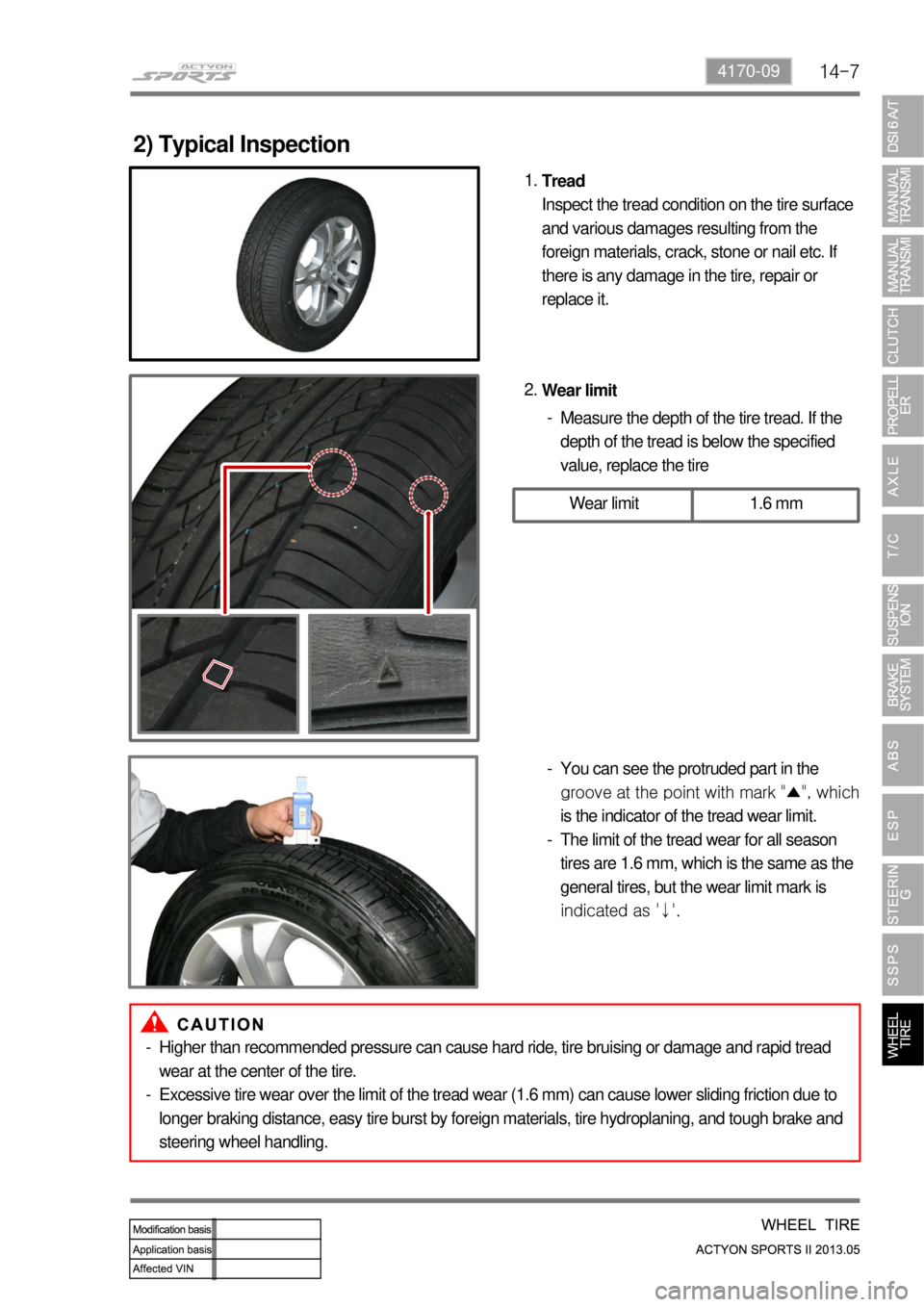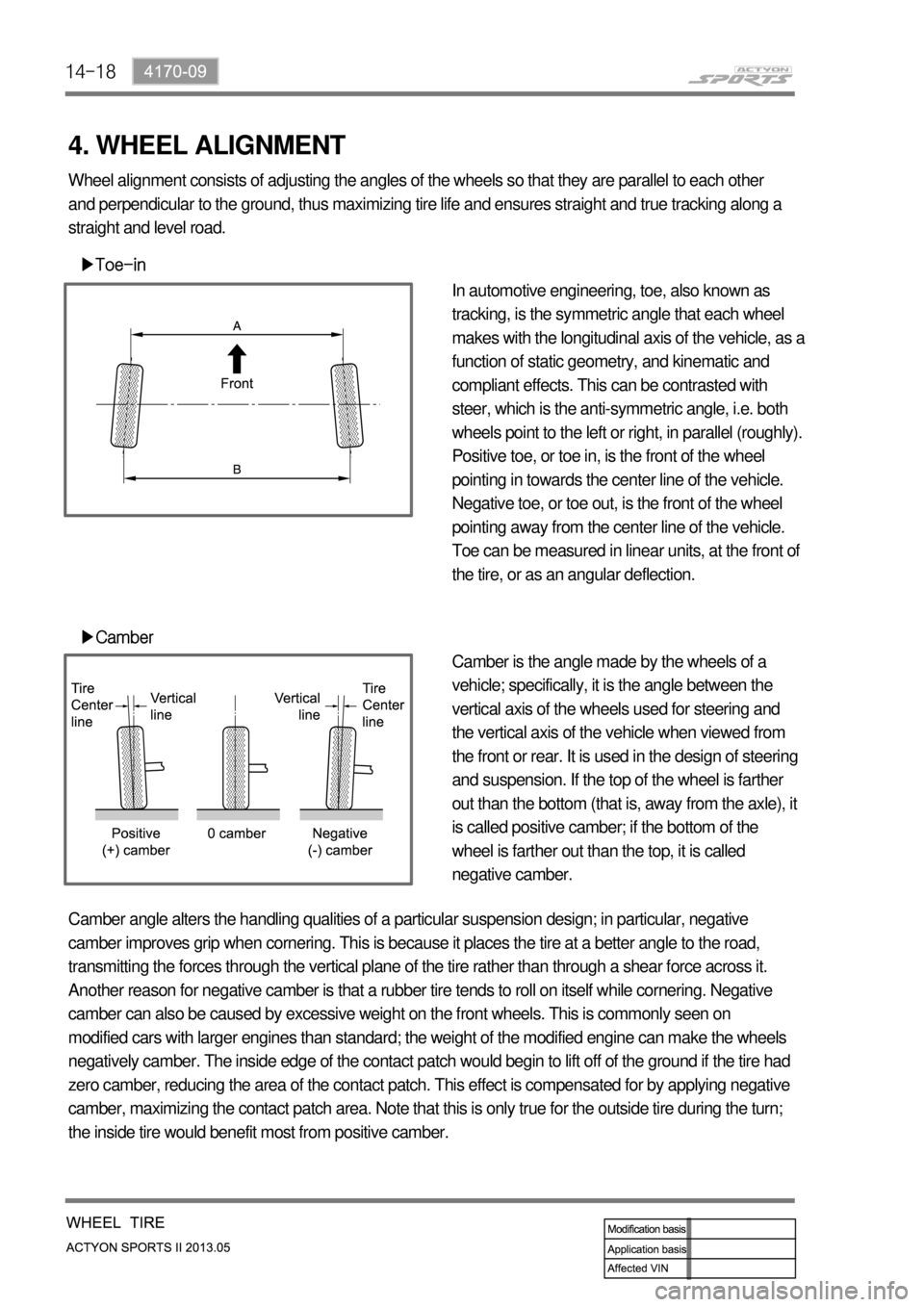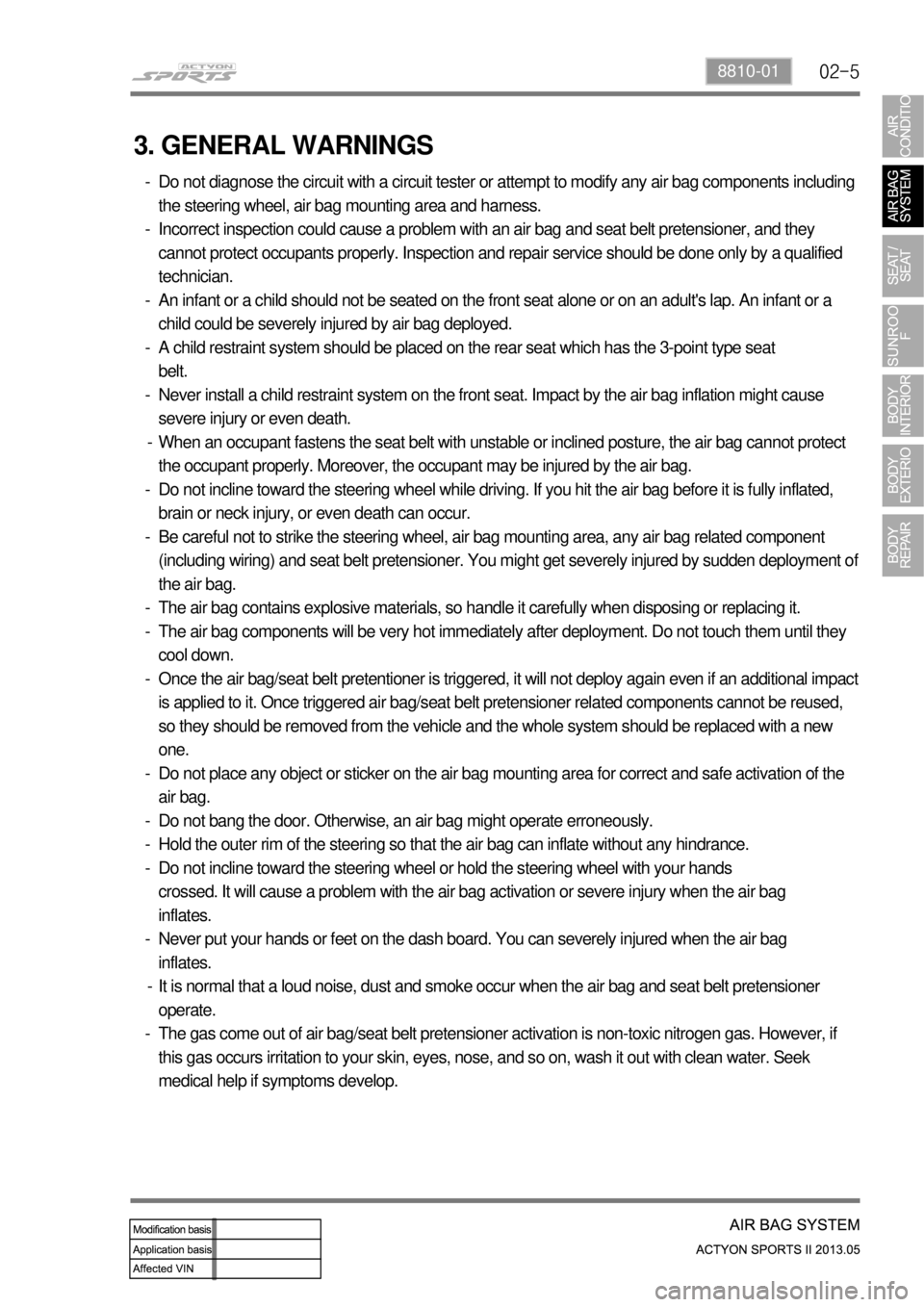steering SSANGYONG NEW ACTYON SPORTS 2013 Repair Manual
[x] Cancel search | Manufacturer: SSANGYONG, Model Year: 2013, Model line: NEW ACTYON SPORTS, Model: SSANGYONG NEW ACTYON SPORTS 2013Pages: 751, PDF Size: 72.63 MB
Page 668 of 751

14-74170-09
2) Typical Inspection
Tread
Inspect the tread condition on the tire surface
and various damages resulting from the
foreign materials, crack, stone or nail etc. If
there is any damage in the tire, repair or
replace it. 1.
Wear limit 2.
Measure the depth of the tire tread. If the
depth of the tread is below the specified
value, replace the tire -
You can see the protruded part in the
groove at the point with mark "▲", which
is the indicator of the tread wear limit.
The limit of the tread wear for all season
tires are 1.6 mm, which is the same as the
general tires, but the wear limit mark is
indicated as '↓'. -
-
Wear limit 1.6 mm
Higher than recommended pressure can cause hard ride, tire bruising or damage and rapid tread
wear at the center of the tire.
Excessive tire wear over the limit of the tread wear (1.6 mm) can cause lower sliding friction due to
longer braking distance, easy tire burst by foreign materials, tire hydroplaning, and tough brake and
steering wheel handling. -
-
Page 677 of 751

14-16
When the vehicle is driven on a road surface covered with water at high speed, tires do not contact with
the road surface but rotate floating on a thin film of water.
It causes brake failure, lower traction force and losing the steering performance.
To prevent this, increase the tire inflation pressure, use tires with leaf shape tread which is not worn.
However, it is a best measure to drive slowly. Hydro Planing ▶
Vehicle speed ≤ 60 km/h
No Hydro planningVehicle speed = 80 km/h
Partial Hydro planningVehicle speed ≥ 100 km/h
Full Hydro planing
Page 679 of 751

14-18
4. WHEEL ALIGNMENT
▶Toe-in
▶Camber
In automotive engineering, toe, also known as
tracking, is the symmetric angle that each wheel
makes with the longitudinal axis of the vehicle, as a
function of static geometry, and kinematic and
compliant effects. This can be contrasted with
steer, which is the anti-symmetric angle, i.e. both
wheels point to the left or right, in parallel (roughly).
Positive toe, or toe in, is the front of the wheel
pointing in towards the center line of the vehicle.
Negative toe, or toe out, is the front of the wheel
pointing away from the center line of the vehicle.
Toe can be measured in linear units, at the front of
the tire, or as an angular deflection.
Camber is the angle made by the wheels of a
vehicle; specifically, it is the angle between the
vertical axis of the wheels used for steering and
the vertical axis of the vehicle when viewed from
the front or rear. It is used in the design of steering
and suspension. If the top of the wheel is farther
out than the bottom (that is, away from the axle), it
is called positive camber; if the bottom of the
wheel is farther out than the top, it is called
negative camber. Wheel alignment consists of adjusting the angles of the wheels so that they are parallel to each other
and perpendicular to the ground, thus maximizing tire life and ensures straight and true tracking along a
straight and level road.
Camber angle alters the handling qualities of a particular suspension design; in particular, negative
camber improves grip when cornering. This is because it places the tire at a better angle to the road,
transmitting the forces through the vertical plane of the tire rather than through a shear force across it.
Another reason for negative camber is that a rubber tire tends to roll on itself while cornering. Negative
camber can also be caused by excessive weight on the front wheels. This is commonly seen on
modified cars with larger engines than standard; the weight of the modified engine can make the wheels
negatively camber. The inside edge of the contact patch would begin to lift off of the ground if the tire had
zero camber, reducing the area of the contact patch. This effect is compensated for by applying negative
camber, maximizing the contact patch area. Note that this is only true for the outside tire during the turn;
the inside tire would benefit most from positive camber.
Page 680 of 751

14-194170-09
▶Caster
Caster is the angle to which the steering pivot
axis is tilted forward or rearward from vertical, as
viewed from the side. If the pivot axis is tilted
backward (that is, the top pivot is positioned
farther rearward than the bottom pivot), then the
caster is positive; if it's tilted forward, then the
caster is negative.
Positive caster tends to straighten the wheel
when the vehicle is traveling forward, and thus is
used to enhance straight-line stability. The
mechanism that causes this tendency is clearly
illustrated by the castering front wheels of a
vehicle. The steering axis of a vehicle wheel is
set forward of where the wheel contacts the
ground. As the vehicle is driving forward, the
steering axis pulls the wheel along, and since the
wheel drags along the ground, it falls directly in
line behind the steering axis. The force that
causes the wheel to follow the steering axis is
proportional to the distance between the steering
axis and the wheel-to-ground contact patch-the
greater the distance, the greater the force. This
distance is referred to as "trail."
Page 714 of 751

02-58810-01
3. GENERAL WARNINGS
Do not diagnose the circuit with a circuit tester or attempt to modify any air bag components including
the steering wheel, air bag mounting area and harness.
Incorrect inspection could cause a problem with an air bag and seat belt pretensioner, and they
cannot protect occupants properly. Inspection and repair service should be done only by a qualified
technician.
An infant or a child should not be seated on the front seat alone or on an adult's lap. An infant or a
child could be severely injured by air bag deployed.
A child restraint system should be placed on the rear seat which has the 3-point type seat
belt.
Never install a child restraint system on the front seat. Impact by the air bag inflation might cause
severe injury or even death.
When an occupant fastens the seat belt with unstable or inclined posture, the air bag cannot protect
the occupant properly. Moreover, the occupant may be injured by the air bag.
Do not incline toward the steering wheel while driving. If you hit the air bag before it is fully inflated,
brain or neck injury, or even death can occur.
Be careful not to strike the steering wheel, air bag mounting area, any air bag related component
(including wiring) and seat belt pretensioner. You might get severely injured by sudden deployment o
f
the air bag.
The air bag contains explosive materials, so handle it carefully when disposing or replacing it.
The air bag components will be very hot immediately after deployment. Do not touch them until they
cool down.
Once the air bag/seat belt pretentioner is triggered, it will not deploy again even if an additional impac
t
is applied to it. Once triggered air bag/seat belt pretensioner related components cannot be reused,
so they should be removed from the vehicle and the whole system should be replaced with a new
one.
Do not place any object or sticker on the air bag mounting area for correct and safe activation of the
air bag.
Do not bang the door. Otherwise, an air bag might operate erroneously.
Hold the outer rim of the steering so that the air bag can inflate without any hindrance.
Do not incline toward the steering wheel or hold the steering wheel with your hands
crossed. It will cause a problem with the air bag activation or severe injury when the air bag
inflates.
Never put your hands or feet on the dash board. You can severely injured when the air bag
inflates.
It is normal that a loud noise, dust and smoke occur when the air bag and seat belt pretensioner
operate.
The gas come out of air bag/seat belt pretensioner activation is non-toxic nitrogen gas. However, if
this gas occurs irritation to your skin, eyes, nose, and so on, wash it out with clean water. Seek
medical help if symptoms develop. -
-
-
-
-
-
-
-
-
-
-
-
-
-
-
-
-
-
Page 716 of 751

02-78810-01
Contact coil
- Heated steering wheel connector adopted and its appearance changed
- Fixing keys (3 off) for engaging with multifunction switch
4. MAJOR CHANGES
Heated steering wheel connector
(to contact coil)
Pin No. Name
1 Ground
2 IGN
3 Heated steering
wheel switch
ON/OFF
4 Heated steering
wheel switch
signal
Fixing key